ignition MITSUBISHI LANCER EVOLUTION X 2008 Owner's Manual
[x] Cancel search | Manufacturer: MITSUBISHI, Model Year: 2008, Model line: LANCER EVOLUTION X, Model: MITSUBISHI LANCER EVOLUTION X 2008Pages: 241, PDF Size: 8.26 MB
Page 114 of 241
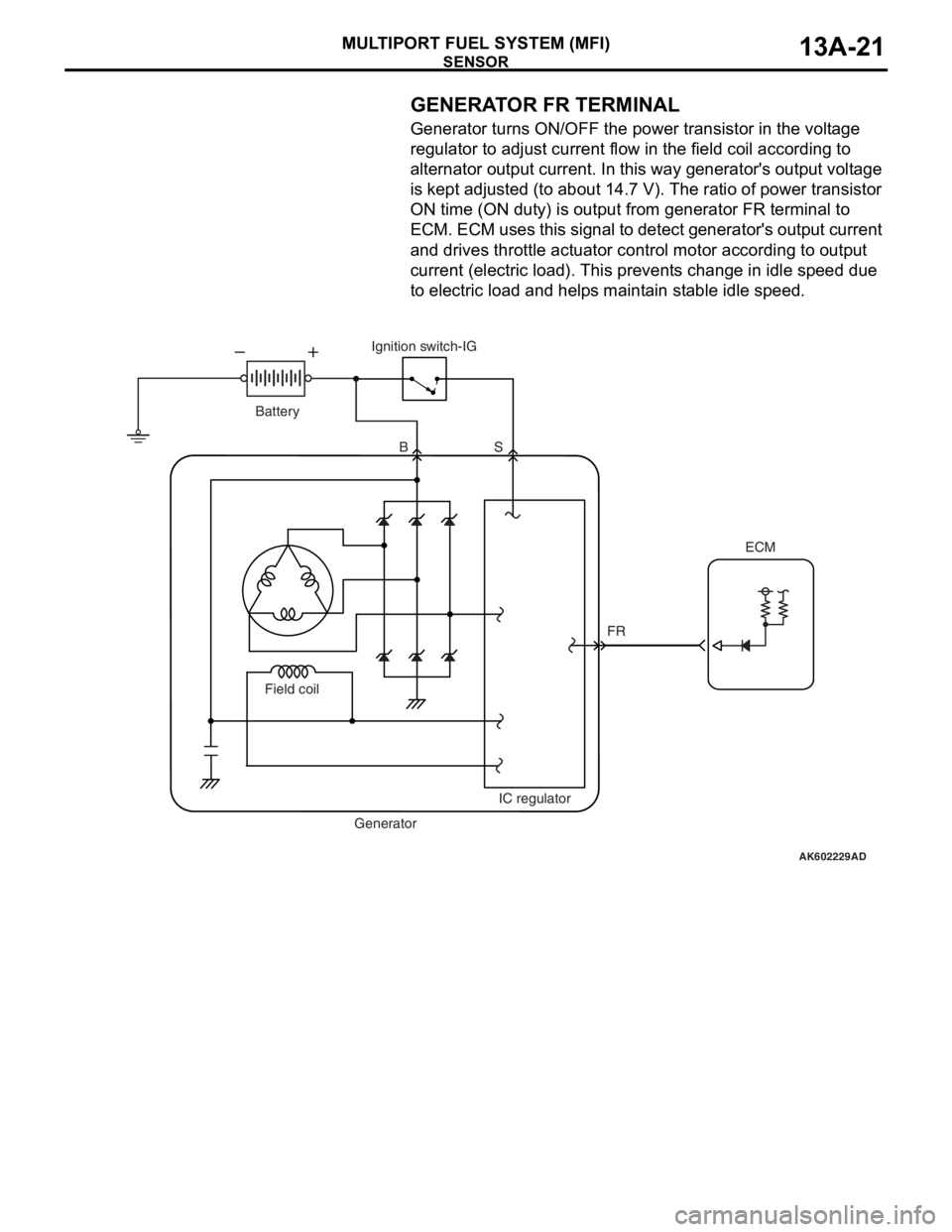
SENSOR
MULTIPORT FUEL SYSTEM (MFI)13A-21
.
GENERATOR FR TERMINAL
Generator turns ON/OFF the power transistor in the voltage
regulator to adjust current flow in the field coil according to
alternator output current. In this way generator's output voltage
is kept adjusted (to about 14.7 V). The ratio of power transistor
ON time (ON duty) is output from generator FR terminal to
ECM. ECM uses this signal to detect generator's output current
and drives throttle actuator control motor according to output
current (electric load). This prevents change in idle speed due
to electric load and helps maintain stable idle speed.
.
AK602229AD
FR BS
Field coil
IC regulator
GeneratorIgnition switch-IG
Battery
ECM
Page 115 of 241
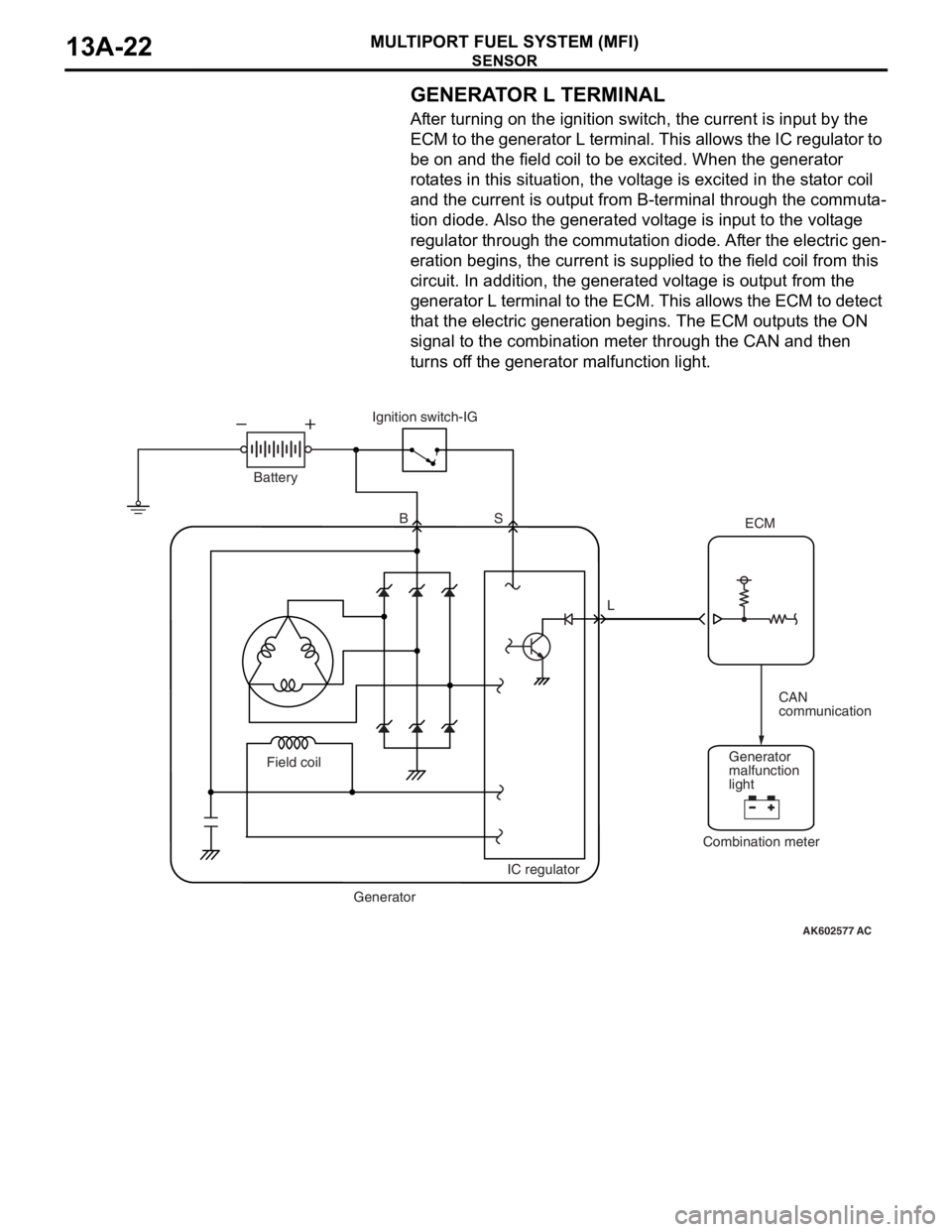
SENSOR
MULTIPORT FUEL SYSTEM (MFI)13A-22
GENERATOR L TERMINAL
After turning on the ignition switch, the current is input by the
ECM to the generator L terminal. This allows the IC regulator to
be on and the field coil to be excited. When the generator
rotates in this situation, the voltage is excited in the stator coil
and the current is output from B-terminal through the commuta
-
tion diode. Also the generated voltage is input to the voltage
regulator through the commutation diode. After the electric gen
-
eration begins, the current is supplied to the field coil from this
circuit. In addition, the generated voltage is output from the
generator L terminal to the ECM. This allows the ECM to detect
that the electric generation begins. The ECM outputs the ON
signal to the combination meter through the CAN and then
turns off the generator malfunction light.
AK602577
L BS
AC
Battery
GeneratorIC regulator Ignition switch-IG
CAN
communication
Generator
malfunction
light
Combination meterECM
Field coil
Page 118 of 241
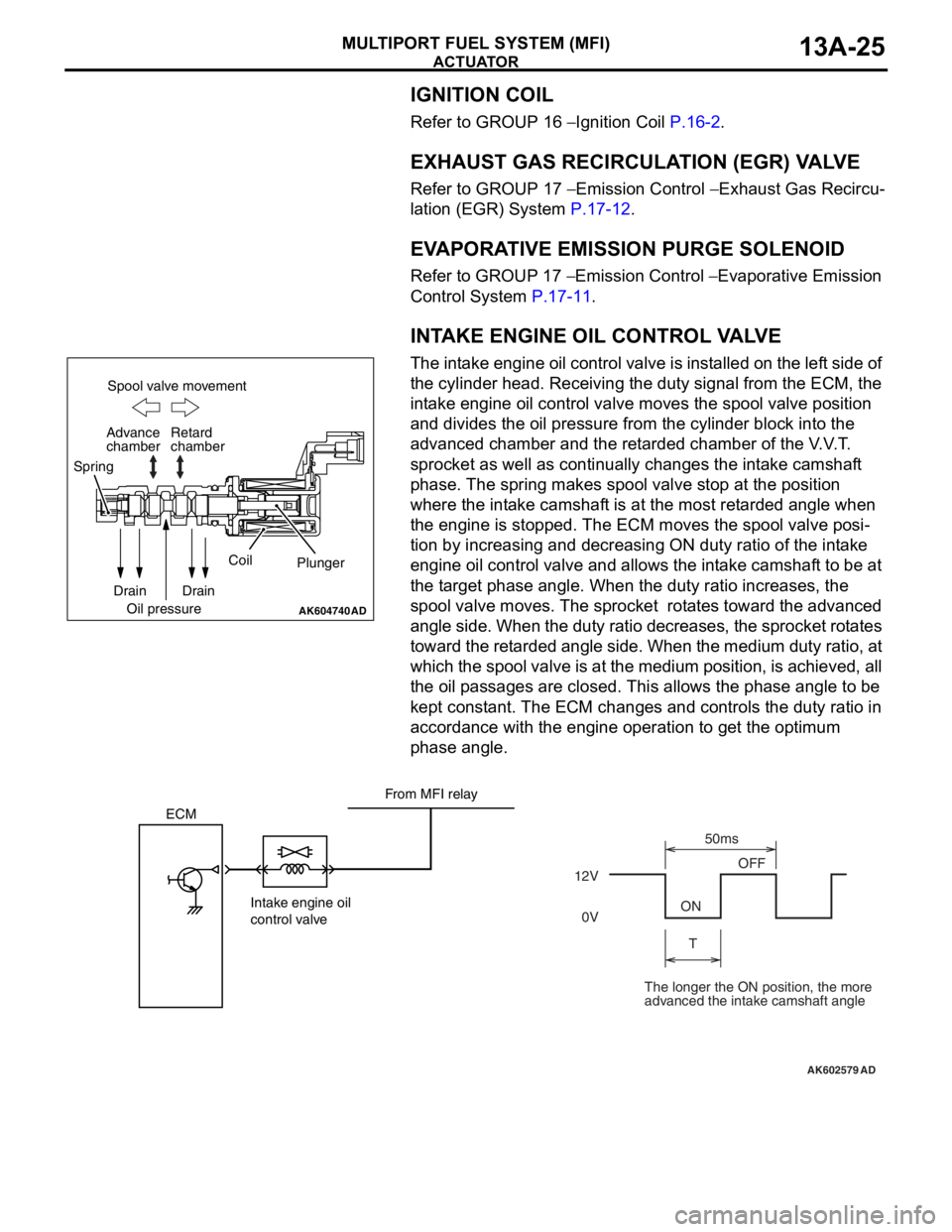
ACTUATOR
MULTIPORT FUEL SYSTEM (MFI)13A-25
IGNITION COIL
Refer to GROUP 16 − Ignition Coil P.16-2.
EXHAUST GAS RECIRCULATION (EGR) VALVE
Refer to GROUP 17 − Emission Control − Exhaust Gas Recircu-
lation (EGR) System P.17-12.
EVAPORATIVE EMISSION PURGE SOLENOID
Refer to GROUP 17 − Emission Control − Evaporative Emission
Control System
P.17-11.
INTAKE ENGINE OIL CONTROL VALVE
The intake engine oil control valve is installed on the left side of
the cylinder head. Receiving the duty signal from the ECM, the
intake engine oil control valve moves the spool valve position
and divides the oil pressure from the cylinder block into the
advanced chamber and the retarded chamber of the V.V.T.
sprocket as well as continually changes the intake camshaft
phase. The spring makes spool valve stop at the position
where the intake camshaft is at the most retarded angle when
the engine is stopped. The ECM moves the spool valve posi
-
tion by increasing and decreasing ON duty ratio of the intake
engine oil control valve and allows the intake camshaft to be at
the target phase angle. When the duty ratio increases, the
spool valve moves. The sprocket rotates toward the advanced
angle side. When the duty ratio decreases, the sprocket rotates
toward the retarded angle side. When the medium duty ratio, at
which the spool valve is at the medium position, is achieved, all
the oil passages are closed. This allows the phase angle to be
kept constant. The ECM changes and controls the duty ratio in
accordance with the engine operation to get the optimum
phase angle.
AK604740AD
Spool valve movement
Retard
chamber
Spring
Drain
Oil pressureCoil
Plunger
Drain Advance
chamber
AK602579
ECM
Intake engine oil
control valve12VOFF
ON
T50ms
0V
AD
From MFI relay
The longer the ON position, the more
advanced the intake camshaft angle
Page 121 of 241

ACTUATOR
MULTIPORT FUEL SYSTEM (MFI)13A-28
GENERATOR G TERMINAL
ECM uses ON/OFF of generator G terminal to control genera-
tor output voltage. When the power transistor in the ECM turns
ON, output voltage gets adjusted to about 12.8 V. When gener
-
ator output voltage drops to 12.8 V it becomes lower than volt-
age of the charged battery and almost no current is output from
the generator. When the power transistor in the ECM turns
OFF, output voltage gets adjusted to about 14.7 V. When gen
-
erator output voltage is about 14.7 V, generator outputs current
to produce electricity. In case electric load is generated sud
-
denly, ECM controls generator G terminal's On-duty to limit the
sudden increase in generator load due to generation and thus
prevents change in idle speed.
AK602233AD
Field coil
IC regulator
GeneratorG Ignition switch-IG
Battery
BS
ECM
Page 122 of 241
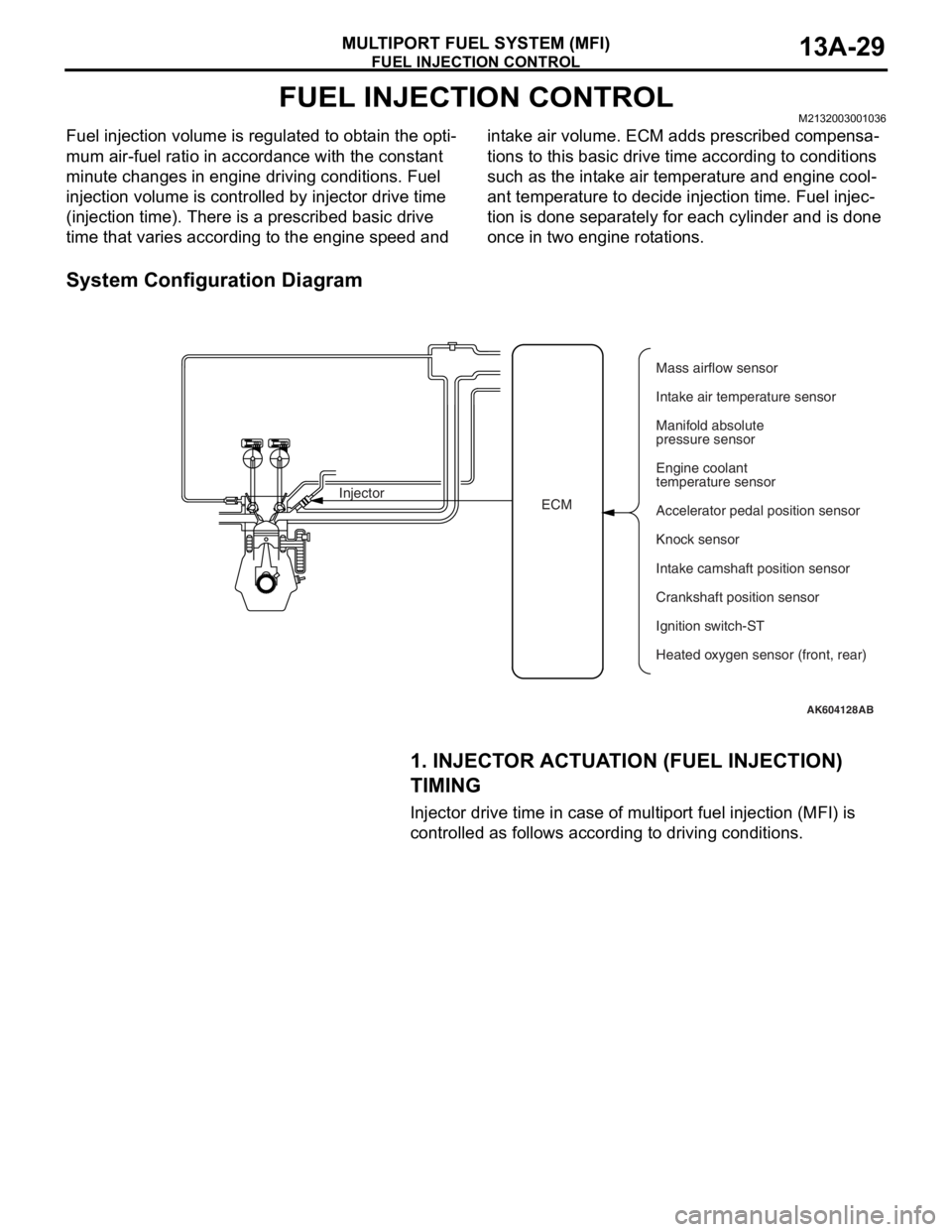
FUEL INJECTION CONTROL
MULTIPORT FUEL SYSTEM (MFI)13A-29
FUEL INJECTION CONTROLM2132003001036
Fuel injection volume is regulated to obtain the opti-
mum air-fuel ratio in accordance with the constant
minute changes in engine driving conditions. Fuel
injection volume is controlled by injector drive time
(injection time). There is a prescribed basic drive
time that varies according to the engine speed and intake air volume. ECM adds prescribed compensa
-
tions to this basic drive time according to conditions
such as the intake air temperature and engine cool
-
ant temperature to decide injection time. Fuel injec-
tion is done separately for each cylinder and is done
once in two engine rotations.
System Configuration Diagram
1. INJECTOR ACTUATION (FUEL INJECTION)
TIMING
Injector drive time in case of multiport fuel injection (MFI) is
controlled as follows according to driving conditions.
AK604128AB
ECM InjectorMass airflow sensor
Intake air temperature sensor
Manifold absolute
pressure sensor
Engine coolant
temperature sensor
Accelerator pedal position sensor
Knock sensor
Intake camshaft position sensor
Ignition switch-ST
Heated oxygen sensor (front, rear) Crankshaft position sensor
Page 128 of 241
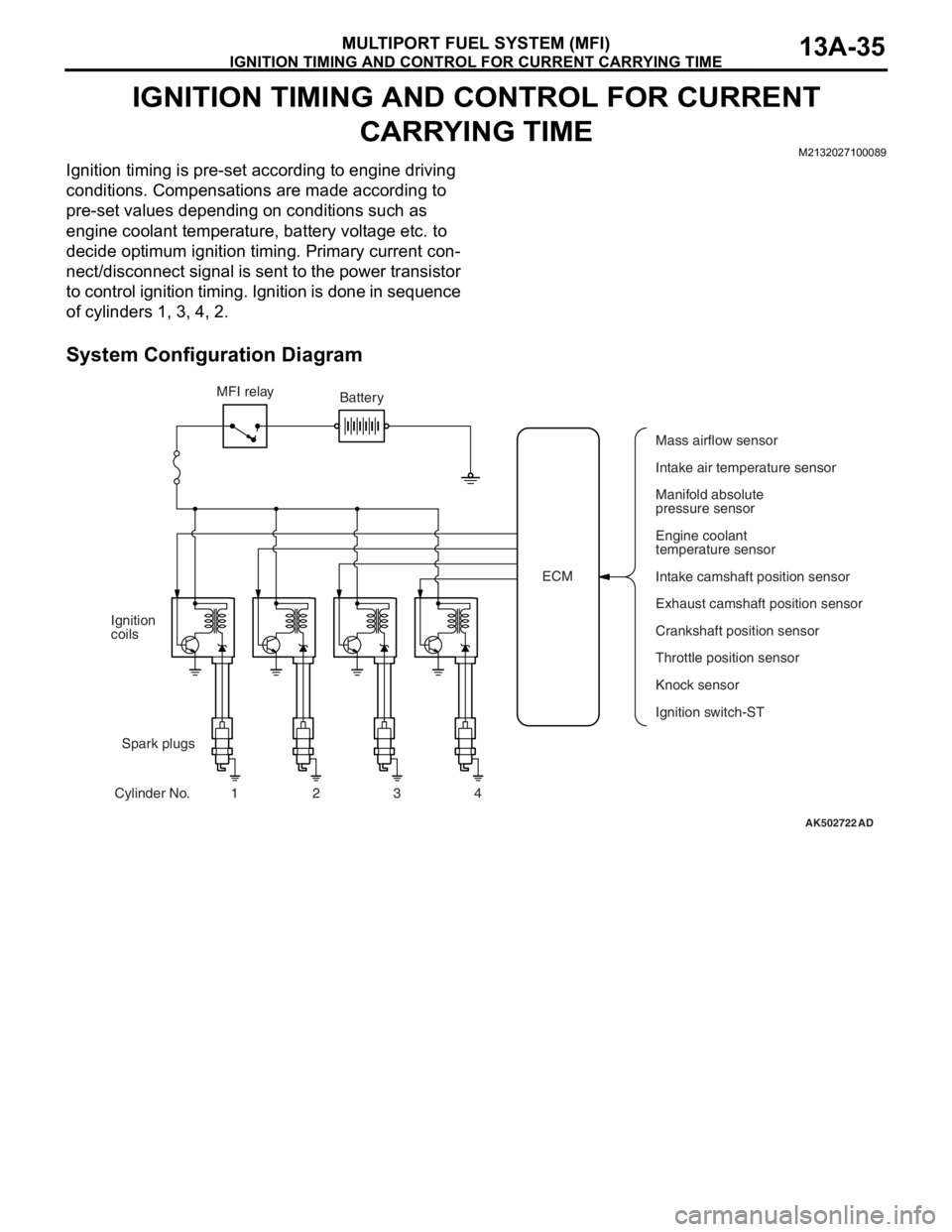
IGNITION TIMING AND CONTROL FOR CURRENT CARRYING TIME
MULTIPORT FUEL SYSTEM (MFI)13A-35
IGNITION TIMING AND CONTROL FOR CURRENT
CARRYING TIME
M2132027100089
Ignition timing is pre-set according to engine driving
conditions. Compensations are made according to
pre-set values depending on conditions such as
engine coolant temperature, battery voltage etc. to
decide optimum ignition timing. Primary current con
-
nect/disconnect signal is sent to the power transistor
to control ignition timing. Ignition is done in sequence
of cylinders 1, 3, 4, 2.
System Configuration Diagram
AK502722AD
ECM MFI relay
Spark plugs Ignition
coils
Cylinder No. 1 2 3 4Battery
Mass airflow sensor
Intake air temperature sensor
Manifold absolute
pressure sensor
Engine coolant
temperature sensor
Intake camshaft position sensor
Exhaust camshaft position sensor
Crankshaft position sensor
Knock sensor
Ignition switch-ST Throttle position sensor
Page 129 of 241
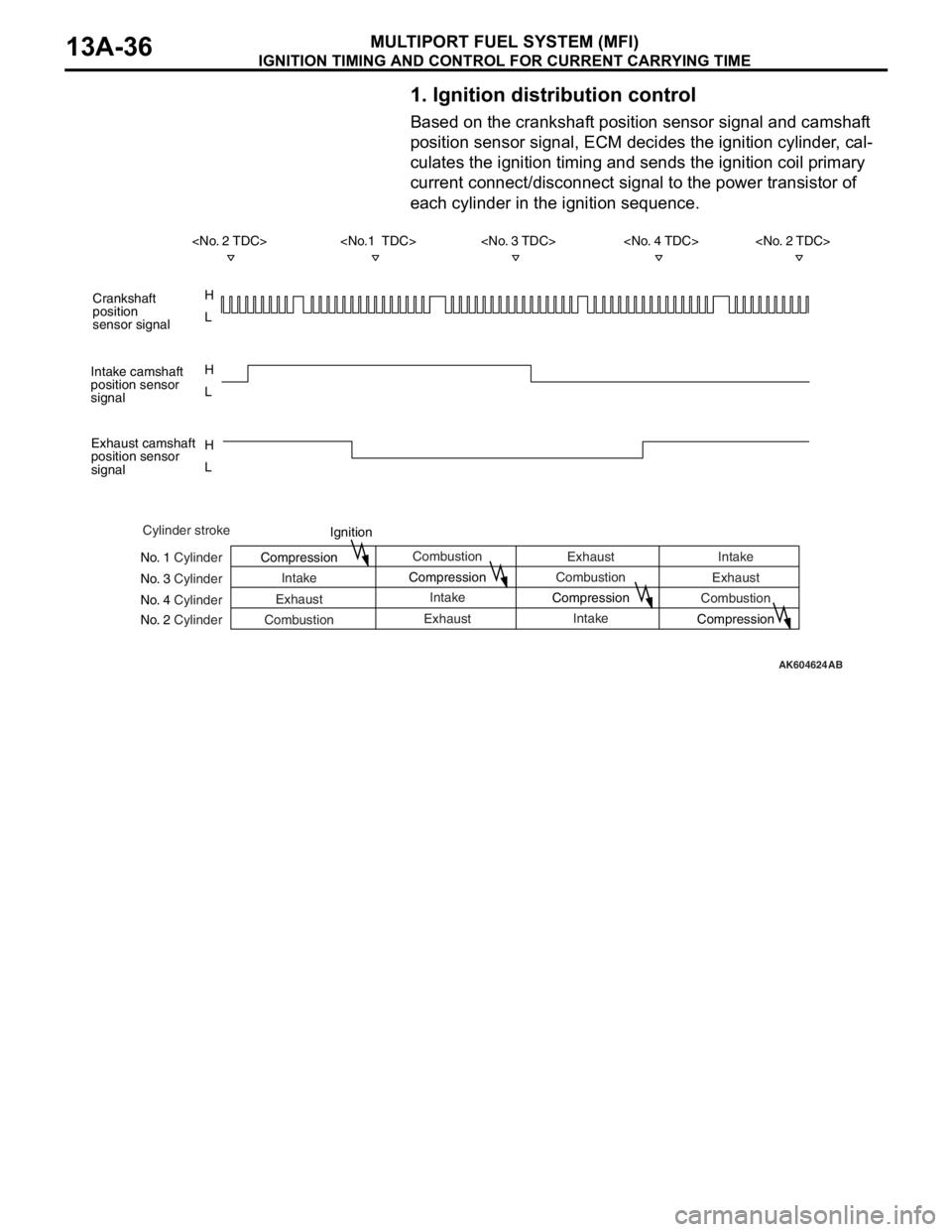
IGNITION TIMING AND CONTROL FOR CURRENT CARRYING TIME
MULTIPORT FUEL SYSTEM (MFI)13A-36
1. Ignition distribution control
Based on the crankshaft position sensor signal and camshaft
position sensor signal, ECM decides the ignition cylinder, cal
-
culates the ignition timing and sends the ignition coil primary
current connect/disconnect signal to the power transistor of
each cylinder in the ignition sequence.
AK604624
Exhaust
AB
Cylinder stroke
No. 1 Cylinder
No. 3 Cylinder
No. 4 Cylinder
No. 2 CylinderCombustion
Intake
Exhaust
Combustion CompressionIgnition
Intake
Exhaust CompressionCombustion
Intake CompressionIntake
Exhaust
Combustion
Compression H
L
H
L
H
L Crankshaft
position
sensor signal
Intake camshaft
position sensor
signal
Exhaust camshaft
position sensor
signal
Page 130 of 241
![MITSUBISHI LANCER EVOLUTION X 2008 Owners Manual IGNITION TIMING AND CONTROL FOR CURRENT CARRYING TIME
MULTIPORT FUEL SYSTEM (MFI)13A-37
2. Spark-advance control and current carrying
time control
.
[During start]
ECM initiates ignition at fixed ign MITSUBISHI LANCER EVOLUTION X 2008 Owners Manual IGNITION TIMING AND CONTROL FOR CURRENT CARRYING TIME
MULTIPORT FUEL SYSTEM (MFI)13A-37
2. Spark-advance control and current carrying
time control
.
[During start]
ECM initiates ignition at fixed ign](/img/19/57326/w960_57326-129.png)
IGNITION TIMING AND CONTROL FOR CURRENT CARRYING TIME
MULTIPORT FUEL SYSTEM (MFI)13A-37
2. Spark-advance control and current carrying
time control
.
[During start]
ECM initiates ignition at fixed ignition timing (5° BTDC) syn-
chronized with the crankshaft position sensor signal.
.
[During normal operation]
After determining the basic spark-advance based on the intake
air volume and engine speed, ECM makes compensations
based on input from various sensors to control the optimum
spark-advance and current carrying time.
List of main compensations for spark-advance control and current carrying time control
.
[Control for checking ignition timing]
During basic ignition timing set mode for M.U.T.-III actuator test
function, sparking is done with fixed ignition timing (5
° BTDC)
synchronized with crankshaft position sensor signal.
CompensationsContent
Intake air temperature compensationCompensation is made according to intake air
temperature. The higher the intake air temperature
the greater the delay in ignition timing.
Engine coolant temperature compensationCompensation is made according to engine coolant
temperature. The lower the engine coolant
temperature the greater the advance in ignition
timing.
Knocking compensationCompensation is made according to generation of
knocking. The greater the knocking the greater the
delay in ignition timing.
Stable idle compensationCompensation is made according to change in idle
speed. In case engine speed becomes lower than
target speed, ignition timing is advanced.
Delay compensation when changing shiftDuring change of shift, sparking is delayed
compared to normal ignition timing to reduce
engine output torque and absorb the shock of the
shift change.
Battery voltage compensationCompensation is made depending on battery
voltage. The lower the battery voltage the greater
the current carrying time and when battery voltage
is high current carrying time is shortened.
Page 132 of 241

THROTTLE VALVE OPENING ANGLE CONTROL AND IDLE SPEED CONTROL
MULTIPORT FUEL SYSTEM (MFI)13A-39
List of main compensations for throttle valve opening angle and idle speed control
Initialize control
After ignition switch turns OFF, ECM drives the throt-
tle valve from fully closed position to fully open posi-
tion and records the fully closed/open studied value
of the throttle position sensor (main and sub) output
signals. The recorded studied values are used as
studied value compensation for compensating basic
target opening angle when the engine is started next.
CompensationsContent
Stable idle compensation (immediately after start)In order to stabilize idle speed immediately after
start, target opening angle is kept big and then
gradually reduced. Compensation values are set
based on the engine coolant temperature.
Rotation speed feedback compensation (while
idling)In case there is a difference between the target idle
speed and actual engine speed, ECM
compensates the throttle valve opening angle
based on that difference.
Atmospheric pressure compensationAt high altitudes atmospheric pressure is less and
the intake air density is low. So, the target opening
angle is compensated based on atmospheric
pressure.
Engine coolant temperature compensationCompensation is made according to the engine
coolant temperature. The lower the engine coolant
temperature the greater the throttle valve opening
angle.
Electric load compensationThrottle valve opening angle is compensated
according to electric load. The greater the electric
load, the greater the throttle valve opening angle.
Compensation when shift is in D range
to some other range, throttle valve opening angle is
increased to prevent reduction in engine speed.
Compensation when A/C is functioningThrottle valve opening angle is compensated
according to functioning of A/C compressor. While
A/C compressor is being driven, the throttle valve
opening angle is increased.
Power steering fluid pressure compensationThrottle valve opening angle is compensated
according to power steering functioning. When
power steering oil pressure rises and power
steering pressure switch is ON, the throttle valve
opening angle is increased.
Page 138 of 241
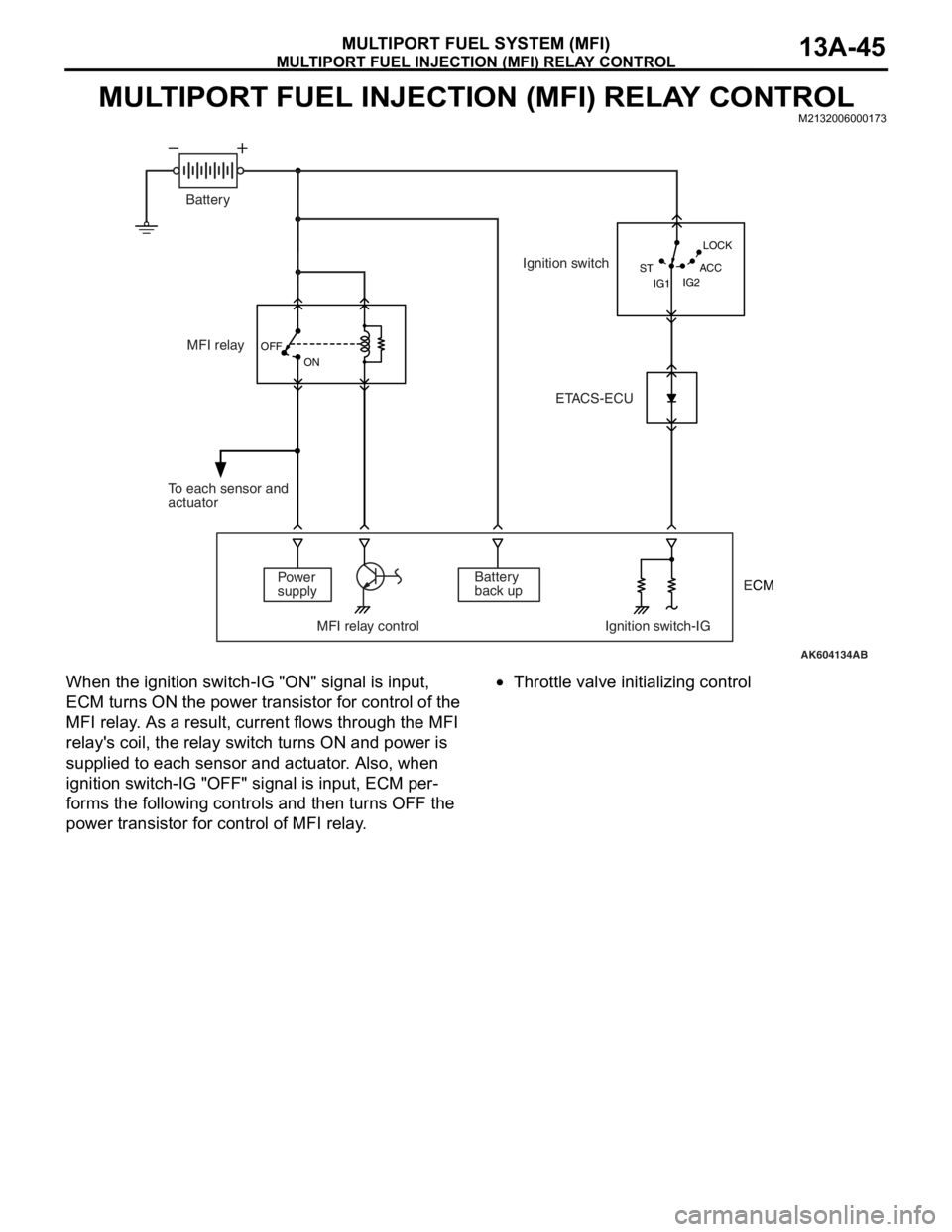
MULTIPORT FUEL INJECTION (MFI) RELAY CONTROL
MULTIPORT FUEL SYSTEM (MFI)13A-45
MULTIPORT FUEL INJECTION (MFI) RELAY CONTROLM2132006000173
When the ignition switch-IG "ON" signal is input,
ECM turns ON the power transistor for control of the
MFI relay. As a result, current flows through the MFI
relay's coil, the relay switch turns ON and power is
supplied to each sensor and actuator. Also, when
ignition switch-IG "OFF" signal is input, ECM per
-
forms the following controls and then turns OFF the
power transistor for control of MFI relay.
•Throttle valve initializing control
AK604134AB OFF
ON
IG2 STLOCK
ACC
IG1
MFI relay
Power
supply
MFI relay control Ignition switch-IGBattery
back up To each sensor and
actuatorIgnition switch
ETACS-ECU Battery
ECM